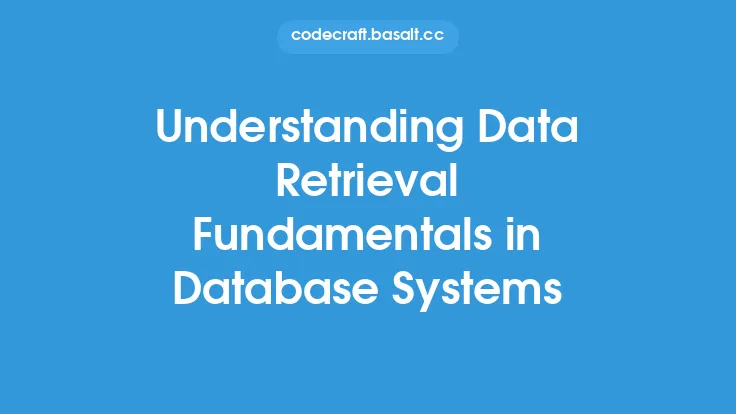Database systems rely heavily on data storage to manage and retrieve data efficiently. At its core, data storage refers to the process of storing, managing, and retrieving data in a database system. This fundamental concept is crucial for any database system, as it directly affects the performance, scalability, and reliability of the system. In this article, we will delve into the basics of data storage in database systems, exploring the different types of data storage, storage devices, and data storage management techniques.
Introduction to Data Storage Types
There are several types of data storage, each with its own strengths and weaknesses. The most common types of data storage are primary storage, secondary storage, and tertiary storage. Primary storage, also known as main memory or random access memory (RAM), is a volatile storage medium that stores data temporarily while the database system is running. Secondary storage, on the other hand, is a non-volatile storage medium that stores data permanently, even when the database system is powered off. Examples of secondary storage devices include hard disk drives (HDDs), solid-state drives (SSDs), and flash drives. Tertiary storage, also known as offline storage or archival storage, is a type of storage that is used to store infrequently accessed data, such as backup tapes or optical disks.
Storage Devices and Media
Storage devices and media play a critical role in data storage. The most common storage devices used in database systems are hard disk drives (HDDs), solid-state drives (SSDs), and flash drives. HDDs use spinning disks and mechanical heads to read and write data, while SSDs use flash memory to store data. Flash drives, on the other hand, use a combination of flash memory and a USB interface to store and transfer data. Other storage devices, such as tape drives and optical drives, are also used in database systems, although less frequently. The choice of storage device depends on factors such as performance, capacity, and cost.
Data Storage Management Techniques
Data storage management techniques are used to optimize data storage and retrieval in database systems. One of the most common techniques is data partitioning, which involves dividing large datasets into smaller, more manageable pieces. Data partitioning can improve query performance, reduce storage costs, and enhance data security. Another technique is data compression, which involves reducing the size of data to save storage space and improve data transfer times. Data encryption is also used to protect data from unauthorized access, by converting plaintext data into unreadable ciphertext. Other data storage management techniques include data replication, data mirroring, and data caching, each with its own benefits and trade-offs.
Storage Capacity and Performance
Storage capacity and performance are critical factors in data storage. Storage capacity refers to the amount of data that can be stored on a storage device, while performance refers to the speed at which data can be read and written. The storage capacity of a device is typically measured in bytes, such as gigabytes (GB) or terabytes (TB). Performance, on the other hand, is measured in terms of input/output operations per second (IOPS), throughput, and latency. The choice of storage device and storage management technique can significantly impact storage capacity and performance, and database administrators must carefully balance these factors to ensure optimal system performance.
Data Storage and Database Design
Data storage and database design are closely intertwined. A well-designed database requires careful consideration of data storage, including the choice of storage device, storage management technique, and data model. The data model, which defines the structure and relationships of data, can significantly impact data storage requirements. For example, a relational database management system (RDBMS) may require more storage space than a NoSQL database, due to the overhead of relational data structures. Database designers must also consider data storage constraints, such as storage capacity and performance, when designing a database.
Best Practices for Data Storage
Best practices for data storage are essential for ensuring optimal system performance, data security, and data integrity. One of the most important best practices is to use a redundant array of independent disks (RAID) to protect against data loss and improve performance. Another best practice is to use data encryption to protect sensitive data from unauthorized access. Regular backups and data archiving are also essential for ensuring data integrity and recoverability. Additionally, database administrators should monitor storage capacity and performance regularly, to ensure that the system is operating within optimal parameters. By following these best practices, database administrators can ensure that their data storage systems are reliable, efficient, and secure.
Conclusion
In conclusion, data storage is a fundamental concept in database systems, and understanding its basics is crucial for any database administrator or designer. The different types of data storage, storage devices, and data storage management techniques all play a critical role in ensuring optimal system performance, data security, and data integrity. By following best practices for data storage and carefully considering data storage requirements, database administrators can design and implement efficient, reliable, and secure data storage systems that meet the needs of their organizations. Whether you are designing a new database system or optimizing an existing one, a deep understanding of data storage fundamentals is essential for success.





